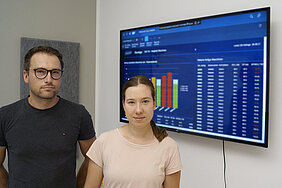Digitalization is daily routine in all the departments: Invoices and sales contracts are no longer processed in hardcopy, meetings take place virtually, tasks are assigned and administered by means of ticket systems. The customers’ plants and production machines are also digitalized. Driven by the customer’s benefit and process optimization, digitalization has already yielded many advantages. The establishment of the DAC (Data Analysis Center) in November 2020 was the next consistent step Doppstadt has taken.
The DAC interlinks machines, service, sales, construction and customers using the possibilities the IoT (Internet of Things) provides. Christoph Naber, head of the processes and IT department, explains: “In simple terms, a sensor is connected to a thing and its data are transmitted to a data analysis centre.” From a technical point of view, the IoT is the connection of physical objects to virtual technology. The aim is to add value to the function of the objects. Naber takes the Smart Home as an example, where decentralized sensors record the temperature, humidity and movement in a house and control the lighting and heating automatically.
A comprehensive data analysis generates precise knowledge about the optimum use of the machine at the customer’s site. We use this knowledge to advise the customers even better recommend them the machine they really need. In addition, we can analyse error messages by remote maintenance and give instructions."
For Doppstadt the IoT means a lot of data at first, whose safety and availability must be ensured. “Data protection is very important and it is one of the standard tasks for us in the IT “, Naber emphasizes. Data Scientist Ayla Jungbluth underlines the benefits: “These data allow us an access to information we did not have before. We at Doppstadt think that the IoT enables our customers and employees to realize unprecedented cases of applications.“ An example: Proactive spare part sales. „Our machines know when they will break and which spare parts they need. Later on, they would buy these parts by themselves activating the whole supply chain.“ Frank Uhlig, DAC data scientist, adds: “In our new IoT portal, we will be able to give the customers a real-time view of their machines and specific instructions. Furthermore, the Doppstadt machines and even external machines can be synchronized.” And: Historical machine data can be used to detect noticeable and recurring errors and thus optimize the design.
Therefore there are various benefits of the IoT. Doppstadt has been working with telematics systems so far, which record sensor data of the machines at certain intervals and store them in databases. This was mainly used by the development and the service department so that it was possible to analyse over 350 machines worldwide via remote maintenance last year and to support the customers. “Just imagine that you have to go to each machine,” explains Ayla Jungbluth.
The DAC strategy expects many more applications, for instance sales and marketing could also benefit from the IoT and the DAC. In general, it can be stated that in the life cycle of a machine, there are a lot of interfaces between final customers and internal specialist departments, from which digital services can be derived. The requirements on the applications also arise from their needs. In the next step, the DAC wants to identify the relevant information from the data overload, visualize it in a way that is easy to understand and derive the necessary actions.


